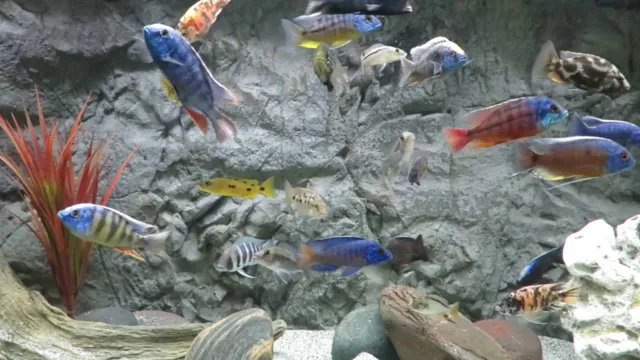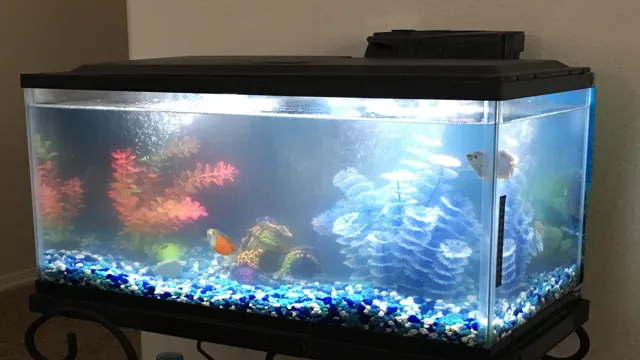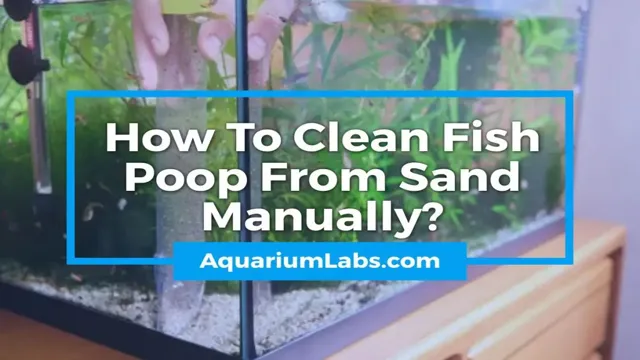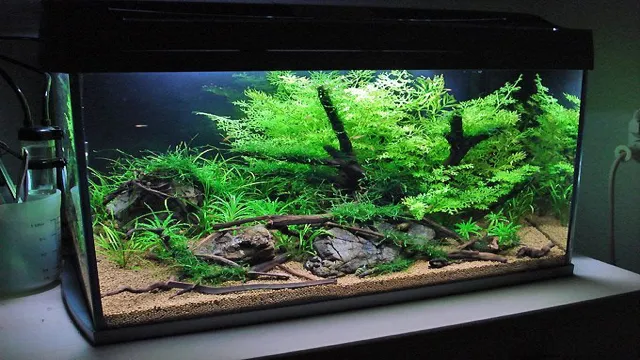Do you feel like your aquarium water is never as clear as you want it to be? Whether you’re a seasoned aquarium owner or new to the hobby, cloudy water can be frustrating and unsightly. Fortunately, there are steps you can take to make your aquarium water crystal clear. In this blog post, we’ll go over some simple techniques that you can use to achieve sparkling clear water in your aquarium.
So, get ready to say goodbye to murky water and hello to a beautifully clear aquarium!
Understanding Cloudy Aquarium Water
If you’re new to aquariums, seeing cloudy water in your tank can be alarming. However, this is a common occurrence that can happen for a variety of reasons. One way to make water clear in an aquarium is by performing regular maintenance.
This includes changing a small percentage of the water every week, vacuuming the substrate, and cleaning off any algae buildup. Another way to keep your water crystal clear is by using a high-quality filter with appropriate media. Make sure to clean or replace the filter as needed to keep it in top condition.
In addition to regular maintenance and filtration, avoid overfeeding your fish, as excess food can contribute to cloudy water. By following these tips, you can enjoy a healthy, thriving aquarium with crystal clear water.
Dissecting the Causes of Cloudy Water
cloudy aquarium water Cloudy aquarium water can be unsightly and is often an indication of problems within the aquarium. One of the most common causes of cloudy water is an excess of organic waste, like fish excretions and uneaten food, which becomes trapped in the water column. This excess waste provides nutrients for bacteria to grow, leading to bacterial blooms that cause cloudiness.
Another cause could be a high level of dissolved solids, such as minerals and other compounds, in the aquarium water. This can be a result of using hard tap water or excessive use of supplements. Additionally, improper filtration can also contribute to cloudy water.
Inadequate filtration does not fully remove debris from the water, which over time will accumulate and cause a murky appearance. Regular water changes, proper filtration, and ensuring a balanced ecosystem can prevent cloudy water in your aquarium.

Monitoring the Environmental Conditions of the Aquarium
Cloudy aquarium water is a common problem that can occur in any aquarium. This condition happens when the water becomes hazy, making it difficult to see the fish and other aquarium inhabitants. The cause of cloudy water can vary, but it is usually due to an increase in organic material in the water.
This can result from overfeeding the fish, overstocking the tank, or inadequate filtration. Other factors that can contribute to the cloudiness of the water include sediment buildup, dead and decaying plants, and bacteria growth. To prevent and treat cloudy aquarium water, it is essential to regularly monitor the water conditions.
You can check the ammonia, nitrite, and nitrate levels using test kits. Routine water changes and cleaning of the filter can also help reduce organics in the water. Additionally, using a UV sterilizer or adding a water clarifier can help reduce cloudy water.
By taking steps to prevent and treat cloudy water, you can ensure that your aquarium remains healthy and thriving for your fish and other aquatic organisms. (See Also: How to Keep Your Fish Aquarium Clean and Healthy: Tips and Tricks)
The Steps to Clearing Aquarium Water
Are you tired of cloudy, murky water in your aquarium? Not only is it unsightly, but it also poses a risk to the health of your fish. Fortunately, clearing up aquarium water is not a complicated process and can be achieved with a few simple steps. Firstly, ensure that your filter is working properly and effectively.
This means checking that it is the correct size for your tank and that the media inside is clean and functioning correctly. Next, perform a water change of around 20-25% of the tank’s volume. Be sure to siphon out any debris or waste while doing so.
Additionally, consider adding some fast-growing plants to absorb excess nutrients in the water. Finally, be patient! It may take a few days to notice a significant improvement, but with consistent maintenance and attention to water quality, your aquarium water will clear up in no time. Remember, a clean and healthy aquatic environment is not only visually appealing but also essential for the wellbeing of your aquatic pets.
Regular Cleaning and Maintenance
Regular cleaning and maintenance are crucial for maintaining a clean and healthy aquarium. One of the most important steps is clearing the water to ensure that your fish have a safe and comfortable home. The first step involves removing any debris or waste from the tank, including uneaten food, dead plants, and fish waste.
You can do this with a siphon or gravel vacuum, which will also help to remove any built-up debris from the bottom of the tank. Next, check and adjust the water chemistry and temperature to ensure that it is within the acceptable range for your fish. You may also want to consider adding a water conditioner to neutralize any harmful substances in the water.
Finally, consider adding a biological filter to the aquarium to help remove harmful bacteria and keep the water clear. By following these steps, you can ensure that your aquarium stays clean, healthy, and enjoyable for your fish.
Introducing Beneficial Bacteria into the Aquarium
Introducing beneficial bacteria is a crucial step towards maintaining a clear and healthy aquarium. First, you need to establish the proper conditions for the bacteria to thrive. This includes maintaining a stable temperature, pH levels, and water quality.
Next, you can introduce the beneficial bacteria either through a commercial product like a bacterial supplement or by using naturally occurring bacteria from an established tank. Once the bacteria is introduced, it will start breaking down waste and other organic matter in the aquarium. This process helps to reduce nitrate and ammonia levels, which are harmful to fish and other aquatic creatures.
Over time, you’ll notice that your aquarium water is clearer and healthier. It’s important to remember that adding bacteria to your tank is not a one-time solution. You need to continue monitoring and maintaining the proper conditions to ensure the bacteria continue to thrive and keep your aquarium water clear.
Overall, introducing beneficial bacteria to your aquarium is a simple and effective way to maintain a healthy aquatic environment.
Utilizing Filtration Systems
Aquarium Filtration Systems Keeping your aquarium water clean and clear is essential for the health and well-being of your aquatic pets. Proper filtration systems can help remove impurities and debris from the water, ensuring a safe environment for your fish. The first step to clearing your aquarium water is to choose the right filtration system. (See Also: How to Get Less Hard Water for Aquarium: Effective Ways to Reduce Water Hardness)
Consider factors such as the size of your tank, the type of fish you have, and the level of waste they produce. Once you have selected the right filtration system, make sure to maintain it regularly by cleaning and replacing filters as needed. Regular water changes and testing can also help keep your aquarium water clean and clear.
Remember, a healthy aquarium starts with a clean and well-maintained filtration system.
Preventing Cloudy Aquarium Water
If you’re an aquarium enthusiast, you know how frustrating it can be when your aquarium water turns cloudy. Not only is it unsightly, but it can also be harmful to your fish and plant life. Luckily, there are a few simple steps you can take to prevent cloudy water in your aquarium.
Firstly, ensure that you’re not overfeeding your fish. This can lead to excess waste and an imbalance of nutrients in the water. Secondly, make sure that you’re changing your water regularly.
A weekly water change is recommended, as it removes any debris or waste that may have accumulated in the aquarium. Finally, consider adding a filtration system to your aquarium. This will help to remove any excess waste and keep the water clear and healthy for your aquatic life.
By following these simple steps, you can ensure that your aquarium water remains clear and healthy for your fish and plant life to thrive.
Managing Feeding Habits
Preventing cloudy aquarium water is an essential part of managing your feeding habits. Overfeeding is one of the primary causes of cloudy water, leading to an increase in organic waste that bacteria and algae feed upon. To avoid this, it’s crucial to follow a feeding routine that only provides the necessary nutrients for your aquatic pets without creating waste.
A useful tip is to feed smaller amounts of food, more frequently, and to remove any uneaten food immediately after feeding. Furthermore, it’s advisable to use a good quality aquarium filter system that removes harmful particles from the water, ensuring that the water remains clean and healthy for your fish to live in. Consistency and persistence are vital when managing feeding habits to prevent cloudy water and maintain a healthy environment for your aquatic pets to thrive.
Controlling Light Exposure
Controlling light exposure is an effective way to prevent cloudy aquarium water. Natural sunlight or excessive artificial light can cause algae growth, which affects the water’s clarity. One solution is to reduce the amount of light exposure by covering the aquarium with a lid or reducing the duration of light exposure.
Another option is to use a timer to regulate the light exposure, providing the necessary amount for aquatic plants and fish while preventing excess light. Additionally, performing regular water changes and cleaning the aquarium and its filters can help remove any accumulating waste or debris that could contribute to cloudy water. By taking these steps, it is possible to maintain a clean and healthy aquarium environment for all its inhabitants, including fish, plants, and aquatic life.
So, if you want crystal clear aquarium water, then don’t forget to control light exposure. (See Also: How to Get Rid of Snails in Planted Aquarium: Effective Strategies and Prevention Tips)
Conclusion and Final Thoughts
In the end, the secret to achieving crystal clear water in your aquarium is not a magical potion or some elaborate formula, but rather a combination of a few simple yet essential steps. Proper filtration, adequate water circulation, regular water changes, and careful monitoring of your aquarium’s inhabitants and environment are the keys to success. Just remember to keep calm and stay consistent with your efforts, and you’ll soon have a brilliantly clear aquarium that you and your fish can enjoy!”
FAQs
What causes cloudy water in aquariums?
Cloudy water in aquariums can be caused by a variety of factors including overfeeding, poor filtration, and excessive waste buildup.
How often should I change the water in my aquarium to keep it clear?
It is recommended to change 10-15% of the water in your aquarium every week to maintain water clarity and quality.
What types of fish and plants can help keep aquarium water clear?
Some fish species like plecos and snails can help to clean the aquarium by consuming algae and waste. Additionally, aquatic plants like hornwort and duckweed can absorb excess nutrients and improve water quality.
Is it safe to use chemicals to clear up cloudy water in my aquarium?
While some chemicals may temporarily clear up cloudy water, they can also harm fish and other aquarium inhabitants. It is safer and more effective to address the root cause of cloudy water through proper maintenance and water changes.
How can I improve filtration in my aquarium to keep water clear?
Upgrading to a higher quality filter or increasing the frequency of filter cleanings can help improve aquarium filtration and maintain water clarity.
Can sunlight affect water clarity in my aquarium?
Yes, direct sunlight can cause excess algae growth and reduce water clarity in aquariums. It is best to place aquariums away from direct sunlight or use a light-blocking cover.
How can I prevent excessive waste buildup in my aquarium?
Avoid overfeeding and use a gravel vacuum to remove uneaten food and waste from the substrate. Gradually increasing the number of fish in the aquarium can also help establish a balanced ecosystem and prevent waste buildup.







